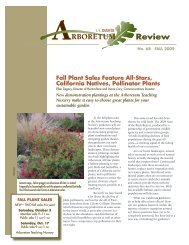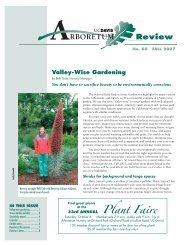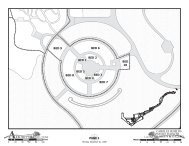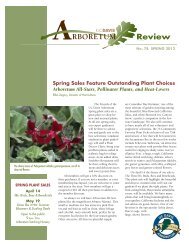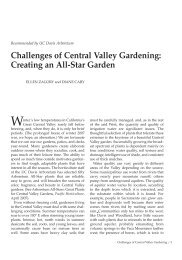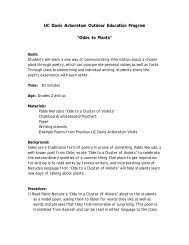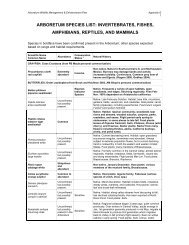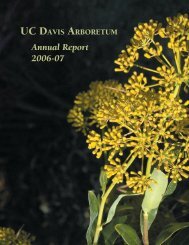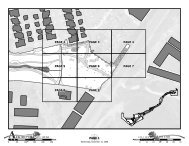All-Stars wildlife brochure.indd - the UC Davis Arboretum
All-Stars wildlife brochure.indd - the UC Davis Arboretum
All-Stars wildlife brochure.indd - the UC Davis Arboretum
You also want an ePaper? Increase the reach of your titles
YUMPU automatically turns print PDFs into web optimized ePapers that Google loves.
ARBORETUM ALL-STARS GREAT WILDLIFE PLANTS FOR CENTRAL VALLEY GARDENS<br />
VINE HILL MANZANITA<br />
Arctostaphylos densifl ora ‘Howard McMinn’<br />
Beautiful dark red, smooth bark, glossy<br />
green leaves, and charming clusters of bellshaped,<br />
pinkish-white fl owers in winter add<br />
year-round interest to this evergreen native<br />
shrub. It is one of <strong>the</strong> few manzanitas that<br />
will tolerate heavy garden soils.<br />
OREGON GRAPE<br />
Berberis aquifolium<br />
Evergreen, spreading shrub, 2 ft. to 6 ft. tall<br />
depending on <strong>the</strong> cultivar. Spiny, holly-like<br />
leaves and bronzy new growth. Will grow in<br />
sun or shade, and is adapted to infrequent<br />
watering. Fragrant yellow fl owers in spring<br />
are followed by blue fruit in winter.<br />
RAY HARTMAN<br />
CALIFORNIA LILAC<br />
Ceanothus ‘Ray Hartman’<br />
Early spring brings a spectacular fl ush of<br />
bright blue, honey-scented fl owers to this<br />
evergreen native shrub. One of <strong>the</strong> best<br />
ceanothus for garden use, it can tolerate<br />
summer irrigation and can be trained as a<br />
small tree. Its fl owers are a nectar source for<br />
benefi cial insects.<br />
WASHINGTON HAWTHORN<br />
Crataegus phaenopyrum<br />
This mid-sized deciduous tree offers many<br />
seasons of interest with profuse white spring<br />
fl owers, ornamental fruit clusters, and brilliant<br />
orange, scarlet, or purplish foliage in<br />
fall. Its graceful open limb structure makes<br />
it an attractive patio specimen.<br />
CALIFORNIA F<strong>UC</strong>HSIA<br />
Epilobium canum<br />
Spreading ground cover, somewhat invasive, good for<br />
low water landscapes. Beautiful red fl owers produced<br />
profusely, attract hummingbirds. Best with full sun<br />
and infrequnt irrigation. Cultivars vary from 4 in. to<br />
4 ft. in height, are deciduous to evergreen, silver grey<br />
to green in color, and have red to white fl owers.<br />
SANTA BARBARA DAISY<br />
Erigeron karvinskianus<br />
This tough, adaptable perennial blooms over a long<br />
period with dainty, pinkish-white fl owers. Good in<br />
containers or for trailing over a wall, it spreads by<br />
seed in <strong>the</strong> garden.<br />
CORAL Y<strong>UC</strong>CA<br />
Hesperaloe parvifl ora<br />
This striking plant adds a strong architectural note<br />
to <strong>the</strong> garden with its spiky leaves and long stalks<br />
of dark coral-pink fl owers. It is especially heat and<br />
drought tolerant and can take full sun, even refl ected<br />
heat. The fl owers are attractive to hummingbirds.<br />
OTTO QUAST<br />
SPANISH LAVENDER<br />
Lavandula stoechas ‘Otto Quast’<br />
The best of <strong>the</strong> Spanish lavenders for this area, with<br />
a compact form, large fl owers, and dark fl ower color.<br />
The gray foliage is attractive all year, and <strong>the</strong> fragrant<br />
fl owers can be used for sachets, perfumes, or soaps.<br />
It is a good container plant for a sunny location.<br />
JAPANESE SILVER GRASS<br />
Miscanthus sinensis (dwarf varieties)<br />
Many varieites of this highly ornamental grass are<br />
available, with different parrterns of leaf variegation<br />
and a range of sizes. It is easy to divide and<br />
propagate, and <strong>the</strong> fl owers are good for arrangements<br />
fresh or dried. The leaves turn vivid reds, oranges and<br />
yellows in fall.<br />
Made possible by a grant from <strong>the</strong> Elvenia J. Slosson Foundation. Photographs by Ellen Zagory, Lauren Broersma, Emily Griswold, Saxon Holt.<br />
MEXICAN DEERGRASS<br />
Muhlenbergia dubia<br />
A striking accent plant for a low-water<br />
garden, this clump-forming grass has<br />
dense tufts of light green, fi ne-textured<br />
leaves. It requires little maintenance<br />
o<strong>the</strong>r than cutting to <strong>the</strong> ground in<br />
winter. Like many grasses, it attracts<br />
benefi cial insects.<br />
GOLDEN CURRANT<br />
Ribes aureum<br />
This deciduous native shrub has beautiful<br />
golden fl owers with spicy fragrance<br />
in late winter and early spring. A good<br />
choice to plant under native oaks.<br />
AUTUMN SAGE<br />
Salvia greggii and Salvia x jamensis<br />
This tough, adaptable evergreen shrub<br />
produces showy red fl owers from spring<br />
through fall. The foliage has a pleasant<br />
citrusy scent. Hummingbirds and butterfl<br />
ies love <strong>the</strong> fl owers.<br />
HUMMINGBIRD SAGE<br />
Salvia spathacea<br />
This tough, drough-tolerant, native<br />
evergreen perennial has striking spikes<br />
of red fl owers in spring and fall. The<br />
leaves have a pleasant fruity fragrance.<br />
Excellent groundcover for dry shade.
WHY PLANT FOR<br />
WILDLIFE?<br />
As development spreads out from California’s<br />
urban centers, more and more wildlands are<br />
converted to housing and industrial uses.<br />
It’s hard for animals to survive when <strong>the</strong>ir<br />
food sources and shelter disappear. Home<br />
gardeners can provide a refuge that supports<br />
local populations of birds and insects and<br />
helps <strong>the</strong>m continue <strong>the</strong>ir ancient patterns<br />
of migration. As an added bonus, <strong>the</strong>y will<br />
pollinate your plants and add sound and<br />
motion to your garden.<br />
POLLINATORS & FLOWERS:<br />
CO-EVOLUTION<br />
Flowers attract pollinators in amazing ways.<br />
Some fl owers have evolved special colors or<br />
produce odors; o<strong>the</strong>rs provide nectar that only<br />
specialized mouth parts can reach. Insect<br />
pollinators are <strong>the</strong> most common, easily<br />
observable on warm days:<br />
• Beetles visit large fl owers with lots of pollen.<br />
• Bees prefer fl owers with landing pads that<br />
refl ect light in <strong>the</strong> ultra-violet range.<br />
• Moths zig-zag <strong>the</strong>ir way through evening<br />
scents to pale fl owers whose fragrance acts<br />
as a beacon.<br />
• Butterfl ies sip nectar from fl owers with <strong>the</strong>ir<br />
long, coiled mouth parts.<br />
In <strong>the</strong> Central Valley, hummingbirds are agents<br />
of pollination. Hummingbirds prefer long,<br />
tubular fl owers that fi t <strong>the</strong>ir slender beaks.<br />
They are especially attracted to red fl owers.<br />
HOW TO ENCOURAGE BIRDS &<br />
INSECTS TO VISIT YOUR GARDEN<br />
• Choose plants that animals use for food and shelter<br />
(see list on back).<br />
• Use a variety of plants that bloom in sequence over<br />
<strong>the</strong> course of <strong>the</strong> year.<br />
• Select plants that grow to different heights and<br />
widths to provide many locations for birds to feed<br />
and build <strong>the</strong>ir nests.<br />
• Use plants that produce silken fi bers to provide<br />
nesting materials.<br />
• Create perches from bare branches for birds to rest<br />
on.<br />
• Provide a water source—a fountain, pool, or<br />
birdbath.<br />
BENEFICIAL INSECTS<br />
FOR PEST CONTROL<br />
You can choose plants for your garden that attract<br />
benefi cial insects—those that prey on insect pests. For<br />
example, syrphid fl ies are common benefi cial insects that<br />
eat aphids. The adults look like small bees, although <strong>the</strong>y<br />
are really fl ies. They hover in <strong>the</strong> air and need nectar<br />
and pollen plants on which to lay <strong>the</strong>ir eggs. The legless<br />
larvae can often be seen on roses dining on aphids.<br />
A NOTE OF CAUTION<br />
While butterfl ies are nectar-sippers, caterpillars are<br />
voracious eaters and can strip <strong>the</strong> leaves off <strong>the</strong>ir<br />
favorite plants. Plant <strong>the</strong> nectar sources in <strong>the</strong> front<br />
of <strong>the</strong> garden and <strong>the</strong> larval food plants in an inconspicuous<br />
place in <strong>the</strong> back. Also, remember that cats<br />
might discourage nesting or kill young birds.<br />
HOW TO<br />
ATTRACT<br />
WILDLIFE<br />
TO YOUR<br />
CENTRAL VALLEY<br />
GARDEN<br />
PROTECT native plants by<br />
supporting <strong>the</strong> pollinators<br />
<strong>the</strong>y depend on<br />
ENJOY <strong>the</strong> sight and sound<br />
of birds and butterfl ies in <strong>the</strong><br />
garden<br />
HELP combat habitat loss by<br />
making your garden a <strong>wildlife</strong><br />
refuge<br />
<br />
GREAT PLANTS FOR CENTRAL VALLEY GARDENS





